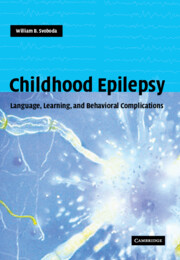Book contents
- Frontmatter
- Contents
- Preface
- Glossary
- 1 Looking ahead
- Part I Speech and language problems
- Part II Learning problems
- 12 Learning challenges
- 13 The development of learning
- 14 Learning difficulties
- 15 Learning problems with seizure types
- 16 Modifying factors
- 17 Transient cognitive impairments of epilepsy
- 18 Attention and alertness
- 19 Memory
- 20 Executive functioning
- 21 Academics
- 22 Antiepileptic medication effects
- 23 Effects of other therapies
- 24 Diagnosis
- 25 Gaining help
- 26 Frustrations of learning problems
- Part III Behavior problems
- Index
- References
16 - Modifying factors
from Part II - Learning problems
Published online by Cambridge University Press: 26 October 2009
- Frontmatter
- Contents
- Preface
- Glossary
- 1 Looking ahead
- Part I Speech and language problems
- Part II Learning problems
- 12 Learning challenges
- 13 The development of learning
- 14 Learning difficulties
- 15 Learning problems with seizure types
- 16 Modifying factors
- 17 Transient cognitive impairments of epilepsy
- 18 Attention and alertness
- 19 Memory
- 20 Executive functioning
- 21 Academics
- 22 Antiepileptic medication effects
- 23 Effects of other therapies
- 24 Diagnosis
- 25 Gaining help
- 26 Frustrations of learning problems
- Part III Behavior problems
- Index
- References
Summary
Epilepsy is not just one disease but rather a symptom of differing neurologic syndromes (Whitehouse, 1976), each of which is subject to multiple variables determining its final manifestation in a child. A combination of factors may determine the final presentation of epilepsy and its consequences. A combination of factors, such as epilepsy syndrome, etiology, presence of a lesion, onset age, frequency, duration, and location of brain involvement, may contribute to global or specific cognitive depression or deterioration (Dam, 1990).
Electroencephalograms
Generalized seizures with early burst suppression, hypsarrhythmia, or slow spike-wave appearance against a slowed background are usually associated with a significant degree of developmental delays and retardation. Slow spike-wave prolonged discharges in slow sleep are often associated with functional regression. A focal discharge on a slowed background, often associated with a symptomatic partial seizure, is at increased risk for specific learning problems. Multifocal spikes are usually associated with intellectual impairment and are often caused by an insult. Even so-called benign partial seizure discharges may not be so benign.
Idiopathic versus symptomatic epilepsy
From an etiologic viewpoint, there are two categories of epilepsy: symptomatic and idiopathic. New investigational methods are reducing the proportion of idiopathic cases (Collins & Lennox, 1947; Price et al., 1948; Ounsted et al., 1966; Rutter et al., 1970; Dam, 1990). There is an intermittent term – cryptogenic epilepsy – used for patients with seizures that resemble a symptomatic form but for which no cause can be found, i.e. a presumed cause being undetected.
- Type
- Chapter
- Information
- Childhood EpilepsyLanguage, Learning and Behavioural Complications, pp. 235 - 251Publisher: Cambridge University PressPrint publication year: 2004



